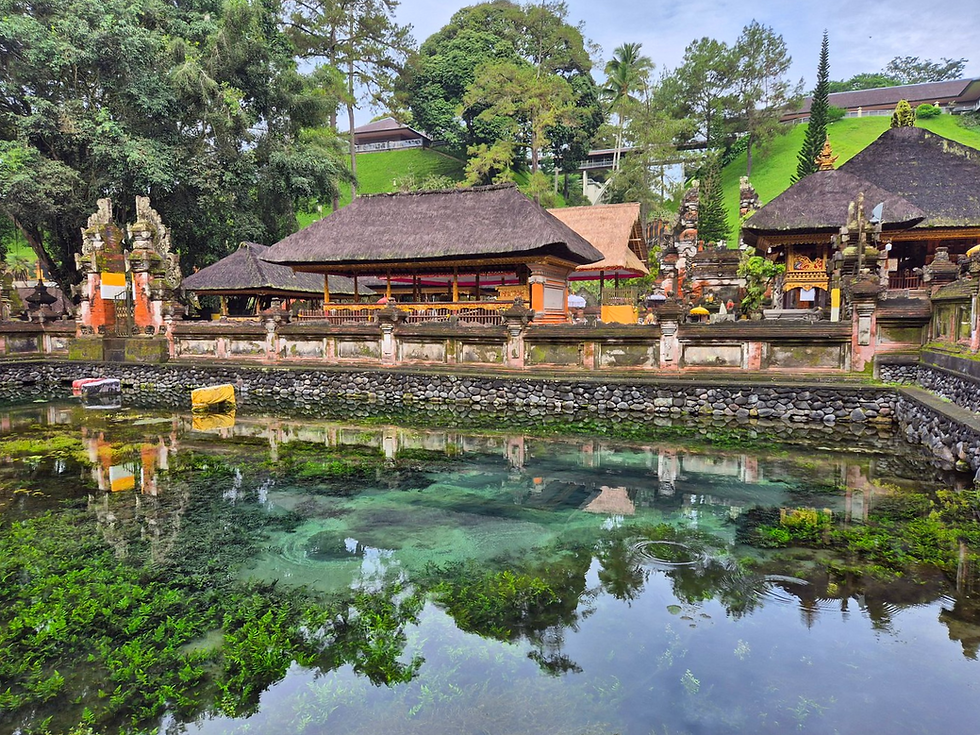Lempuyang Temple - Heaven's Gate
- Shannon
- Sep 1
- 5 min read
Sacred Heights - The Origins of Lempuyang
Standing proudly at 1175 metres above sea level, on the peak of Mount Lempuyang, this ancient temple complex is among Bali’s oldest and most revered, believed to predate most Hindu temples on the island. Although there is some confusion about the site’s exact age, the establishment of temples here stretches back at least a millennium. Supported by ancient inscriptions known as the Sading and Bangsul epigraphs, they provide insight as to how the Lempuyang temples came to be. According to one version, around 993AD, a Balinese king named Jayacakti was instructed by his father to travel to Mount Lempuyang and build a temple there to bring spiritual protection and renewal to the island. Another version tells of the Hindu god Shiva, revered in Bali as Lord Paramecwara, sending his divine son to watch over the land and safeguard its people.

Located amongst the clouds, this temple complex is often considered on par with Bali’s mother temple, Besakih. Facing the cool mountain forests and the towering presence of the mighty Mount Agung, the Lempuyang Temple complex unfolds along a steep ascent of over 1700 stone steps. This sacred pilgrimage route winds through seven temples staggered along the mountain’s slope, beginning with Pura Penataran Agung, often called the "Gate of Heaven," where the volcano is perfectly framed by towering white split gates (or candi bentar). Restored in 2001, this lower temple marks the first tier of the journey and serves both as a spiritual threshold and an iconic photo stop. As pilgrims continue upward, they pass through Telaga Emas, where golden frogs sing with a sound like birdsong and Telaga Sawang, where a sacred fountain flows year round, believed to cleanse those who seek purification. Mount Lempuyang itself is divided according to Balinese cosmology: the base represents Brahma, the middle Vishnu and the sacred summit, where Pura Lempuyang Luhur stands, is dedicated to Shiva.

The temple complex is considered one of Bali’s six holiest sites, known collectively as the Sad Kahyangan Jagad or the “Six Sanctuaries of the World.” These temples are believed to be the spiritual pillars of the island, providing balance and protection. Lempuyang also holds a vital role as one of Bali’s nine directional temples or Pura Kahyangan Jagad, often referred to as the “palaces of the gods.” These temples are strategically placed at the cardinal points and the island’s centre to shield Bali and its people from spiritual imbalance. Lempuyang represents the east, known as purwa, symbolised by the colour white and governed by the god Iswara, the divine protector of the eastern realm.
Towering above the Lempuyang temple complex, Mount Agung casts a long shadow, both literal and spiritual. More than just Bali’s highest peak, Agung is a living deity, its eruptions seen not as accidents of nature but outbursts of divine wrath. Coiled deep within its molten core is the dragon Basuki, a cosmic serpent said to have helped carry the mountain from Java before vanishing into its fiery depths. This is no tame guardian, Basuki is a force of balance and destruction, whose gold shedding scales are as legendary as his fury. When tremors ripple through the island, the high priests of Lempuyang respond with ancient rites, offerings, purifications and whispered invocations meant to pacify the dragon and keep chaos at bay. These are not mere rituals but desperate negotiations with something vast, old and watching.

Heaven’s Gate - Bali’s Lempuyang Temple looking at Mount Agung
Agung is also the island’s spiritual compass. It defines kaja and kelod, mountainward and seaward, a sacred polarity that shapes every aspect of Balinese life. The mountain marks the place where gods dwell and ancestors wait to descend again. It is believed to have been born from a shard of Mount Meru, the mythical axis between heaven and earth, placed here to anchor the world. But this anchor does not rest quietly. The water that flows from Agung is said to carry purity from the source, descending into chaos as it nears the sea, just as spirits drift from the sacred into the profane. Even sleep must align with this force. In the dark heart of the crater, the dragon stirs, his presence a warning. When harmony fractures, the mountain will speak.
Mount Lempuyang is more than just a stunning pilgrimage site, it is a profound meeting place where Bali’s natural majesty, spiritual power and the darker forces hidden within its volcanic heart converge. Every step upward is a journey through breathtaking landscapes and deep layers of history, myth and mystery, where the divine and the dangerous intertwine. Reaching Pura Lempuyang Luhur at the summit demands an arduous 4 hour return hike and local lore warns pilgrims not to grumble on the way up or risk never reaching the peak. This belief underscores the temple’s spiritual challenge, teaching that patience and endurance are essential paths to enlightenment. Those who persevere are rewarded with sweeping panoramic views of the eastern Bali mountain range, lush rural valleys and a profound sense of connection to the island’s sacred core.
🗺️ Location
Mount Lempuyang, Bunutan Village, Karangasem, East Bali, Indonesia
🚆 How to get there
Lempuyang Temple is located in East Bali, about 57 km's from the popular beach area of Kuta and roughly 45 km's from Ubud. Depending on traffic, the drive from Kuta typically takes 2 - 3 hours, while from Ubud it usually takes around 2 hours. Due to its mountainous location and limited public transportation, the best way to reach the temple is by hiring a private car and driver, which generally costs no more than 700,000 IDR for a full day. Visitors often budget an entire day for the trip to see other attractions along the way and may need to depart as early as 3am to make the most of the journey. The drive itself is scenic, winding through traditional villages, rice terraces and lush landscapes that offer a glimpse into rural Balinese life before arriving at the temple’s stunning mountain setting.
⭐ Attraction Info
The entrance fee to Lempuyang Temple is currently 150,000 IDR per person, which includes the use of a sarong and scarf for respectful entry as well as the shuttle service from the parking area up to the temple entrance. The temple is officially open from about 7am until 5pm but remains accessible 24 hours for worshippers. The famous “Gates of Heaven” photo is an illusion created with a simple mirror trick, where local staff position a mirror beneath your camera to mimic a water reflection and while there’s no official fee for this, a small donation to the helper will be expected. Due to the photo’s immense popularity, wait times often range from two to four hours, especially during mid-morning, so arriving as early as 6 AM is recommended to beat crowds and capture the best light or you can skip the wait and enjoy the temple’s spiritual atmosphere instead. Keep an eye on the weather, any clouds will obscure your view of Mount Agung.

















